Renault Trafic E-Tech van review (2024)
Renault completes the electrification of its range, with the Renault Trafic E-Tech mid-size van
PROS
- Smooth and simple to drive
- Comes in multiple lengths and heights
- Range is competitive for the sector
- Decent payload
- Able to tow
CONS
- Only one battery and motor option
- Range is under 200 miles
- No battery regeneration settings
- Overly sensitive steering
- Lacks modern tech of some EVs
Summary
For a brand that was one of the front runners when it came to offering an electric van, Renault has taken its time when creating a mid-size van with a battery-powered motor.
The Renault Trafic E-Tech is finally on the way to join the smaller Renault Kangoo E-Tech and the large electric van, the Master E-Tech. It shares plenty with both of these - it offers the motor from the former and the battery from the latter, but it manages to provide a driving and cabin experience that is somewhere between the two as well.
This is because this is not a brand new van - Renault has taken the same approach that it took with the Master and converted an existing van. However, this is not a mini Master, as the Trafic as a whole benefits from a much more modern cabin and a better driving experience than Renault's ageing large van.
It isn't quite a Kangoo either, though. There are some crucial differences between the two vans, despite the shared features.
What versions of the Renault Trafic E-Tech can you get?
In one sense the number of versions of Trafic E-Tech is quite simple, as there is just the one battery and motor combination available, which means it offers less choice than some of its best medium van rivals. Others offer a version with a choice between battery sizes, which brings options when it comes to range and payload. No such thing with the Trafic, though, where Renault has done the choosing for you.
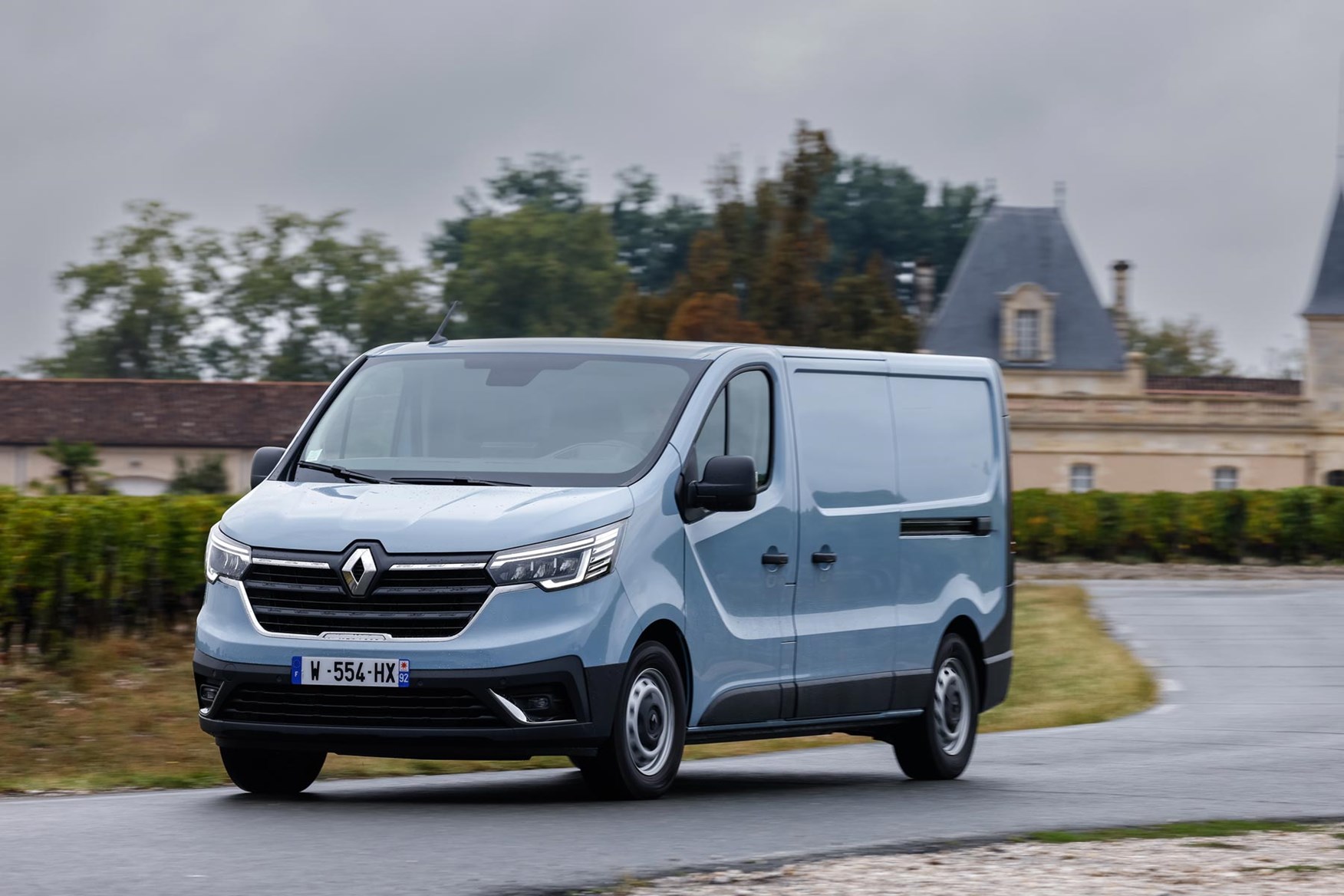
There is a long-range version that offers a little more mileage, but this is achieved by limiting the speed rather than boosting the battery.
However, the Renault has a big differentiating factor in its favour, in that it is the only electric mid-size van that comes with a choice of both lengths and heights. Some will let you get a longer model, but this is the only EV van that comes with two roof options. The lengths are 5,008mm and 5,048mm while the heights are an urban-friendly 1,967mm and a useful 2,498mm.
What are the Renault Trafic E-Tech's rivals?
There are plenty of rivals for the Renault Trafic E-Tech, but also a few notable gaps in the sector. The main rivals are the ones from the Stellantis brands, namely the Citroen eDispatch, Fiat E-Scudo, Peugeot e-Expert and Vauxhall Vivaro Electric. You can add the Toyota Proace Electric to this too - Toyota isn't part of the Stellantis group, but it offers a rebadged version of the same vehicle, albeit with the brand's industry leading 10-year warranty.
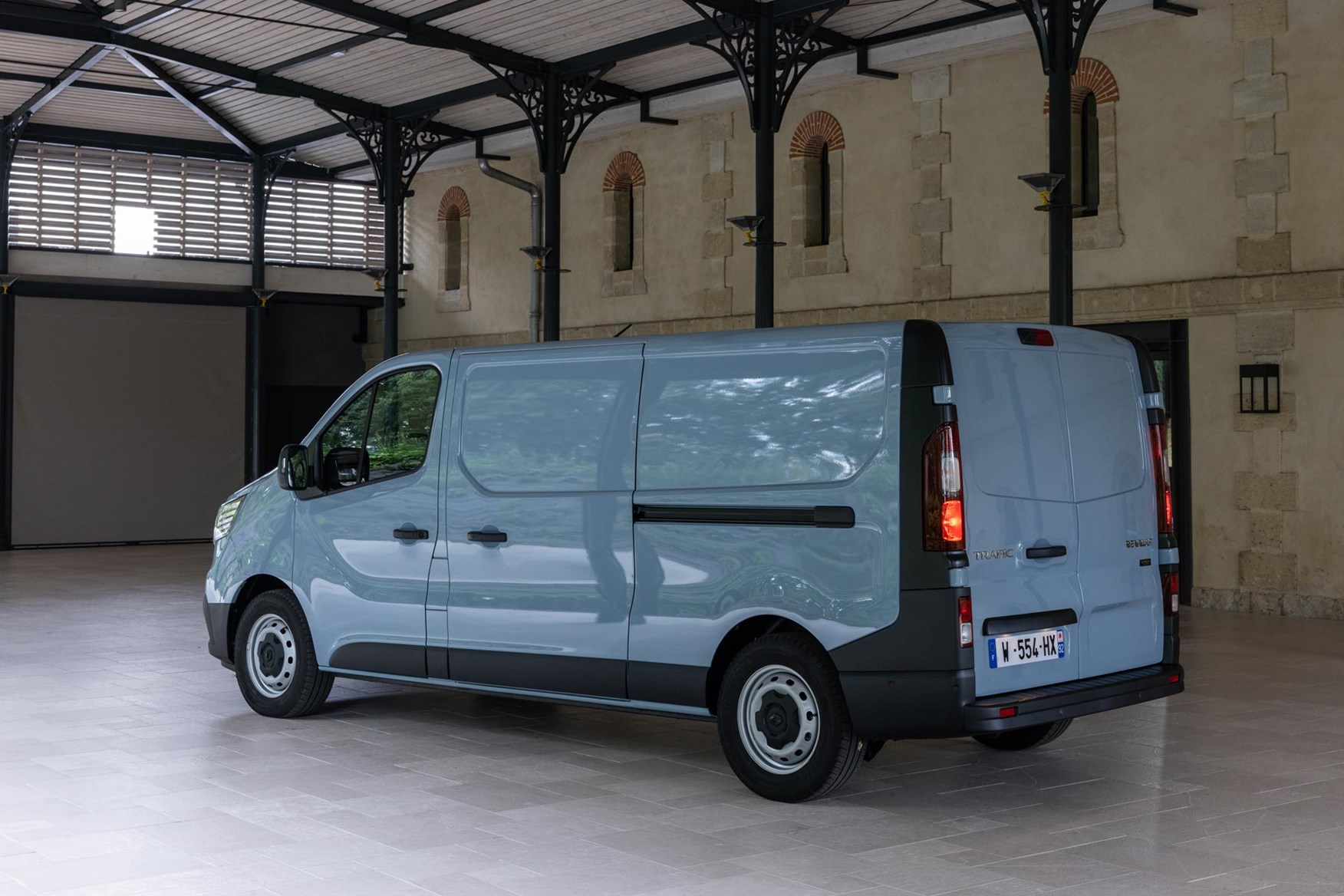
Ford is yet to produce an electric Transit Custom, but this is coming in 2024. This vehicle was co-developed with Volkswagen, so it follows that the 2024 VW Transporter will also come with an electric version.
The Mercedes-Benz eVito is another worthy contender. Early models were not much cop with their limited range, but recent battery updates have brought it up to being competitive. The Maxus eDeliver 3 lacks some of its rivals' modern touches, but makes up for it with a decent and accurate electric range.
Is the Renault Trafic E-Tech any good?
It's early days at this stage, as Renault has yet to release many of the key details required to form a total judgement on whether you should buy an electric Trafic versus one of its rivals. There is, for example, no pricing, no information on specification and limited detail on payload.
However, what we have seen so far is positive. It is a relatively simple electric van that doesn't feel like it is hampered by the conversion from diesel. It doesn't feel like it has been dramatically enhanced to the standards that are possible, though.
It enters the market as a strong box ticker - you won't feel as though you are in the worst possible option, but there is a slight sense that you don't have the best you can get either.
Skip to our full verdict on...
- Simple electric setup
- Over-light steering
- Limited top speed
The Trafic E-Tech plays it very safely and simply when it comes to how it drives. There is very little in the way of trickery, which is handy in some senses but a little disappointing in others.
It's useful as it means that there should be no major intimidation for anyone who hasn't spent much time behind the wheel of an electric vehicle, but it also leaves you feeling slightly like it could do a little more.
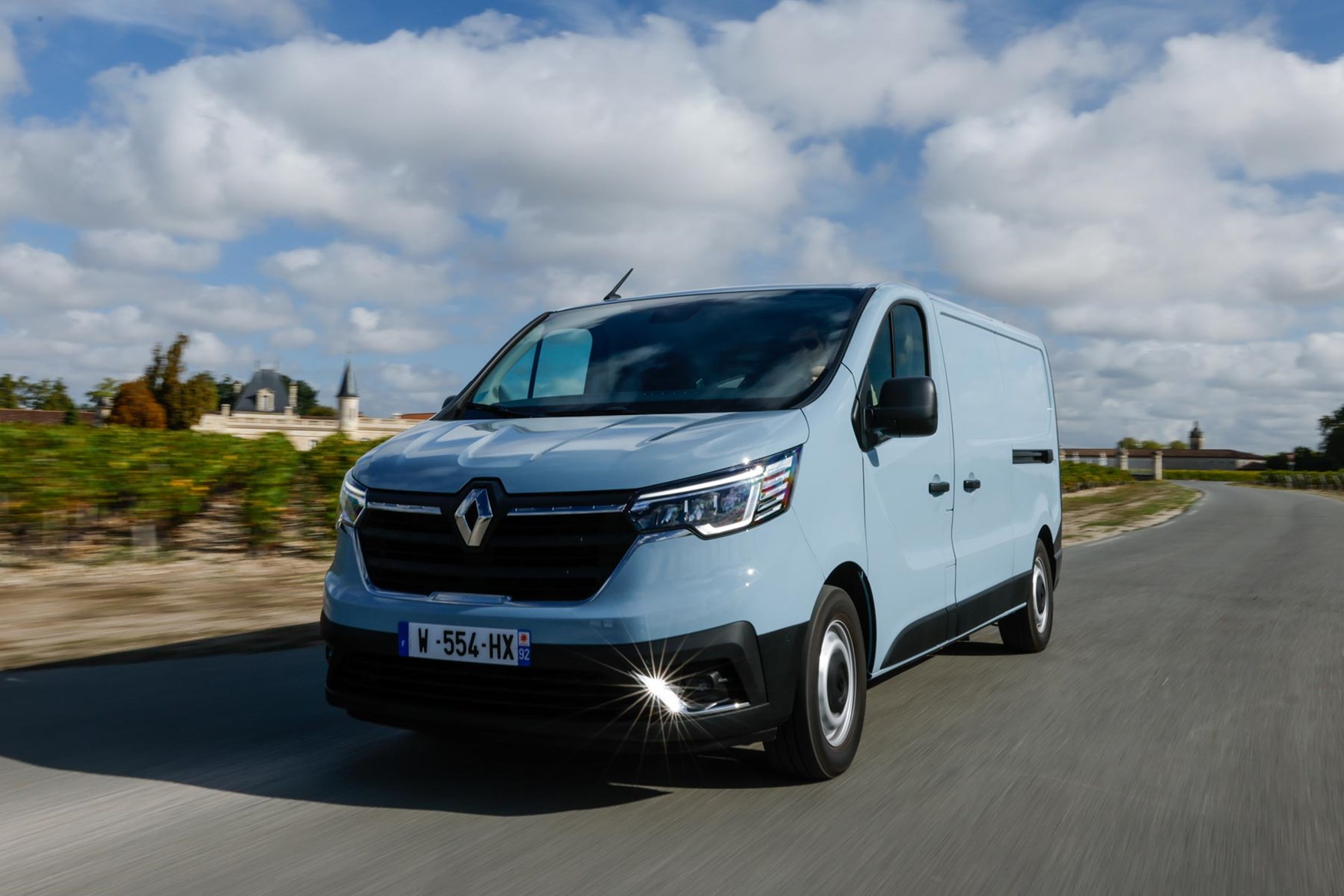
It comes with keyless start as standard, so getting going is a simple case of stepping into the cab and pressing a button. There is, as is ever the case with starting up an electric vehicle, very little drama beyond that. The gear lever is a standard one, so it is then just like driving an automatic Trafic in that you slot it into D and get going. There is, however, something slightly old-school - a manual handbrake. This seems at odds with the modernity of an EV, as almost all come with an automatically disengaging electronic parking brake these days.
Renault Trafic E-Tech ride and handling
The lack of drama continues on the move, as the Trafic E-Tech has a composed and settled ride at lower speeds, which continues as the pace picks up. It's occasionally slightly firm, but it feels controlled and isn't in any way impacted by the redistribution of the weight brought about by the addition of a battery and motor. Our caveat here is that we have yet to try one empty - the vans we got into were all carrying 300kg of payload in the loading bay. This was enough to mean it was more than empty, but not so much that it had a drastic impact on how the van drove.
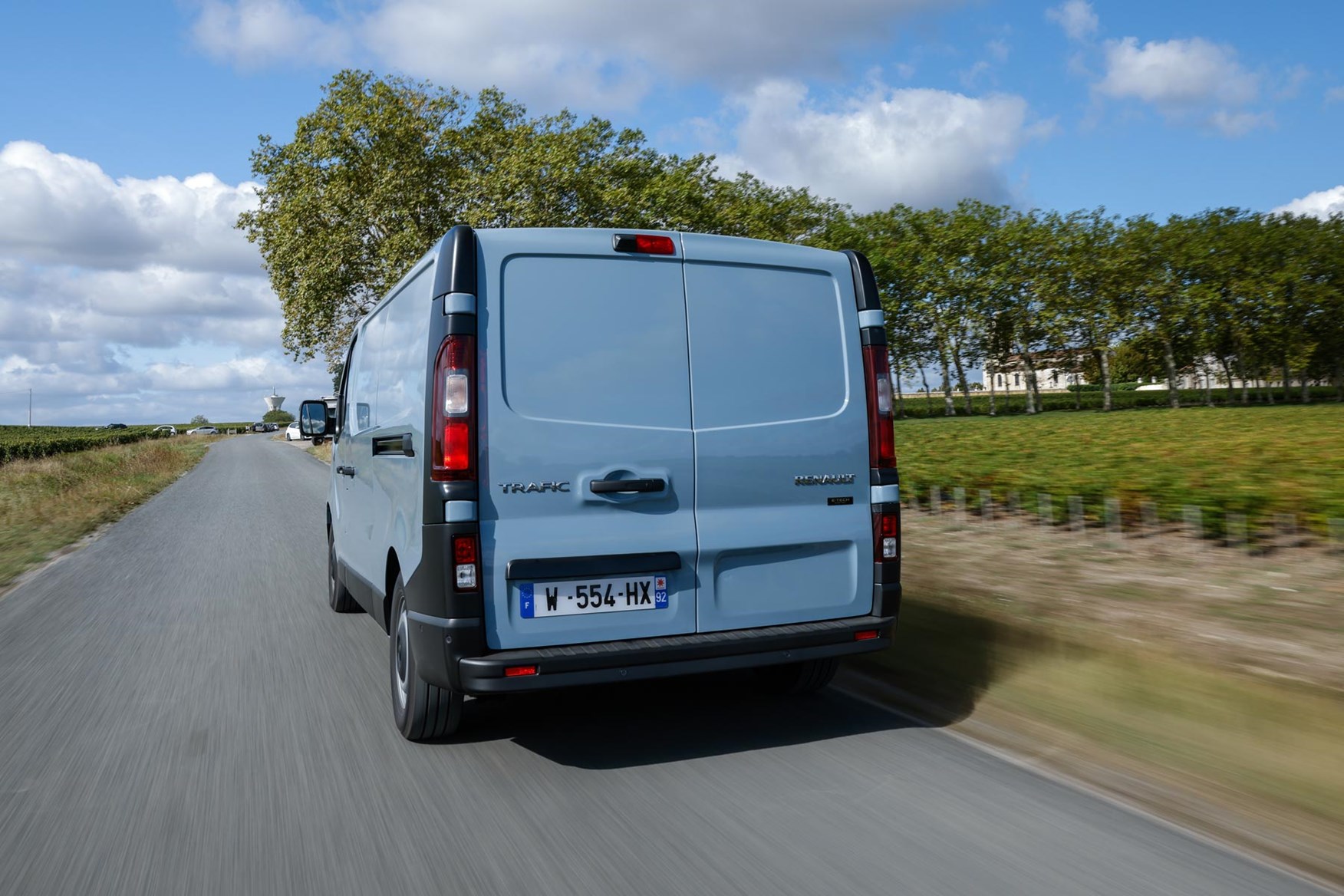
The steering is quite light on the whole, meaning you don't need much effort to change direction. This is fine at lower speeds, but less so when you get onto a faster, straight road. We found you needed to be alert to it at all times, making small corrections just to keep it going in a forward direction.
No electric cleverness
There are almost no settings that you can play with on the Trafic E-Tech, not like, say, the Kangoo E-Tech. The smaller van has regenerative braking that you can adjust to vary the amount that the vehicle will slow itself down when you lift off the accelerator. This is something that is particularly handy in stop-start traffic, as it means you not only get a little boost of battery charge as the van slows itself down, but it also saves a little on brake wear. Win win. The idea is that you can then dial it right back so the regeneration doesn't kick in at all on the motorway.
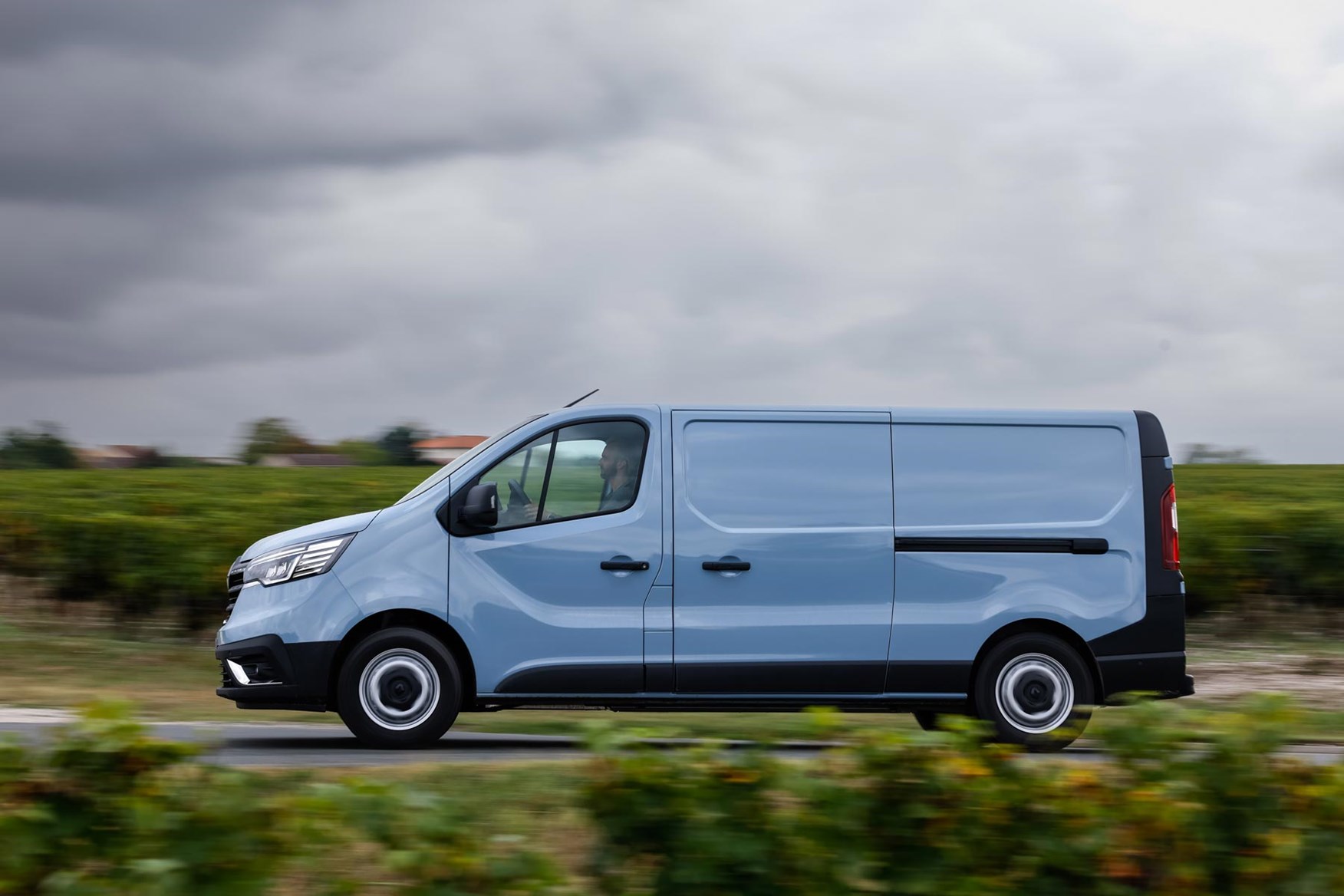
However, none of this exists in the Trafic E-Tech. Renault has simply set the level of brake regeneration that you are allowed and told you to deal with it. The regen level is slightly higher than you might want, especially if you are spending much time out of town. Around town it is better, but it doesn't scrub off speed as rapidly as the highest setting on the Kangoo E-Tech.
There is an Eco mode, but it doesn't impact brake regen, just the accelerator responsiveness, so it doesn't offer the boost in range that you might want if you are getting close to the end of your electric reserves.
Tried and tested motor
The motor in the Trafic E-Tech is the one out of the Kangoo, which is welcome news as it is responsive, smooth and well suited to dealing with the demands of a larger van. There is only the one power output option, with 122hp available.
It never feels too flustered, not loaded with a 300kg payload at least, but it isn't exactly rapid. Oddly, Renault quotes a 0-62mph time of 13.6 seconds, but in reality it might take much longer than that as you might not ever get there - there is set to be a long range Trafic E-Tech that is limited to a top speed of just 56mph. The benefit of that is that you get 200 miles of range rather than the usual 186.
- Standard Trafic fare
- Room for three, simple modern dash
- High level of tech
The Trafic E-Tech's cabin is very much like the diesel version's, as the modifications are minor and sympathetically integrated. The dashboard is where the majority of the alterations are found, as the rev counter has been swapped out for a more EV-appropriate dial that displays where the power is going. It's neatly integrated, though, and easy to read.
Although the final spec levels are yet to be set, it's highly likely that the central 8.0-inch screen is going to be a standard feature on the Trafic E-Tech. This means that it will come with various features such as integrated satellite navigation. For those that have moved on from such things, though, the good news is that you also get wireless smartphone mirroring so you can use Google Maps or the navigation app of your preference instead.
Car-like layout
The dashboard in the Trafic was only updated in 2022, so the E-Tech gets a suitably modern layout and design with various features that wouldn't look out of place in the brand's passenger car range.
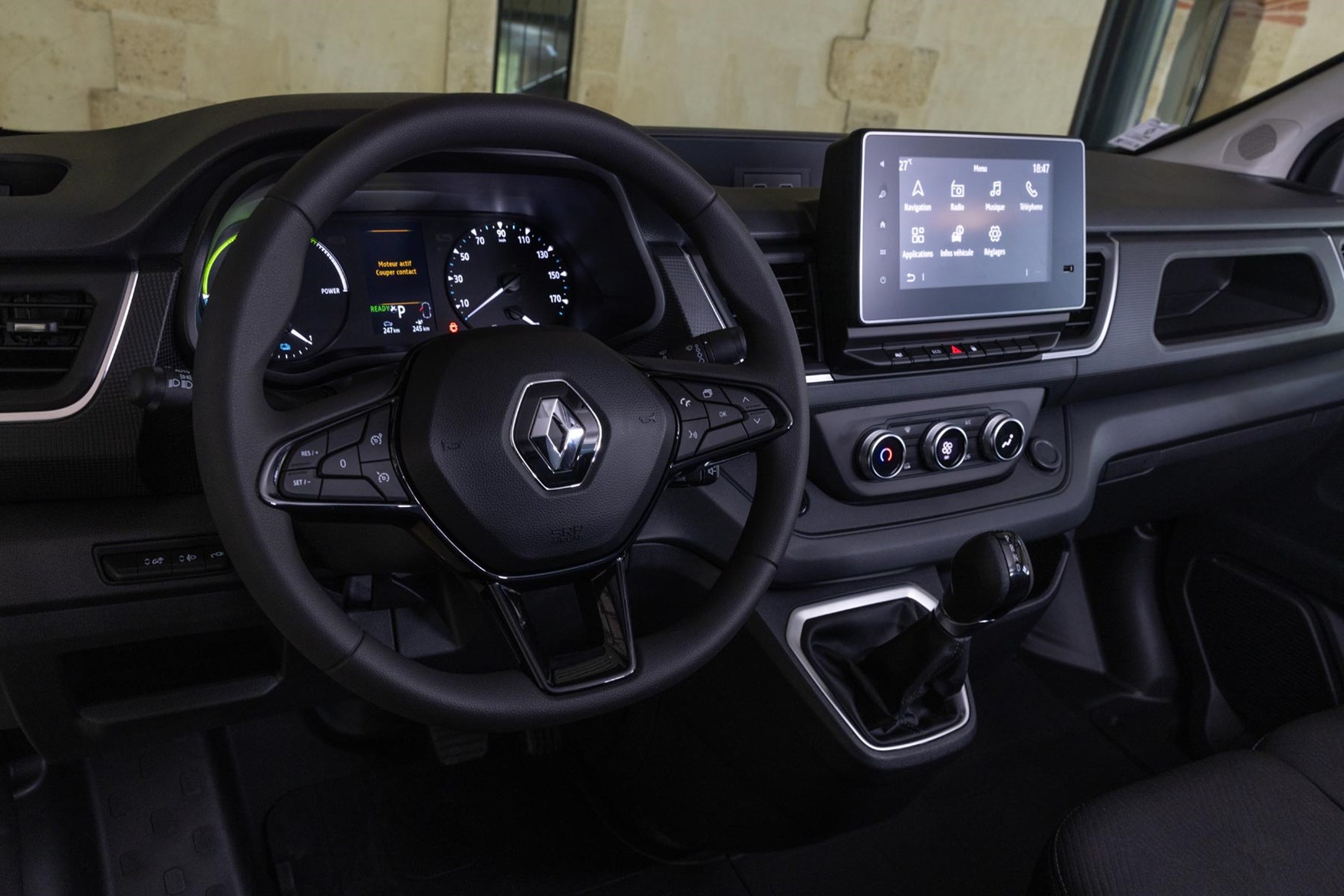
The buttons on the steering wheel, for example, allow you to control a vast array of features, while the controls on the dash are simple and neatly laid out. There are three USB connections - two up in a dash-top storage box and one on the screen and three dials below the screen for controlling the heating system. A couple of physical buttons below the screen will allow you to hit necessary functions easily and rapidly, even with a gloved hand.
There is a good amount of storage around the Trafic's cabin, even if it is not immediately obvious. There is a pair of large door pockets, a large area under the passenger seat and several slots on the top of the dash.
The Trafic is a good option if you need to get three adults in alongside each other. There is welcome amount of width so you won't bash shoulders with one another. It's a shame that the dash design is unchanged, as the gear lever still sticks into the legroom area for the middle passenger.
- Pricing starts just under £40,000
- Single specification level
The Renault Trafic E-Tech gets a simple range, with only the one trim on offer. This is the Advance trim, which is the lower of the two versions that are offered on the standard diesel Trafic, but it still comes with a decent level of kit.
Pricing is relatively simple as well, thanks to that single-model approach. At the time of launch, the SL model starts at £39,500 (not including VAT). However, this is not factoring in the plug-in-van grant - apply for that and you could take off another £5,000 to take the price down to £34,500.
Upgrading to the longer model with the low roof adds £750, while the long wheelbase with the high roof adds a further £1,000.
Renault Trafic E-Tech battery, range and charging
There is one battery available in the Trafic E-Tech - the 52kWh battery that is also found in the old Master van and it offers a standard range of 186 miles. This can be boosted to just over 200 miles if you get the long range version that limits top speed to 56mph, but you will have to drive it sympathetically to do so - there is very little in the way of settings that will influence how the van behaves.
Renault is also offering fast charging on all its Trafic E-Techs, with 7kW AC home capability and the ability to plug into a 50kW DC charger on a public point. It'll take eight hours to charge on your home 7kW wallbox and around an hour on the fastest chargers.
Renault Trafic E-Tech warranty
As is standard for electric vehicles, the Trafic E-Tech also gets an eight-year 100,000-mile warranty on the battery. The rest of the vehicle gets Renault's standard three-year, 100,000-mile warranty.
Renault Trafic E-Tech servicing intervals
The service intervals for the Renault Trafic e-Tech are the standard two years/24,000 miles.
Renault Trafic E-Tech standard equipment
There is only the one trim for the Trafic E-Tech, which is Advance. This is the lower of the two offered on the diesel model, but it still gets a decent amount of kit. Below are some of the highlights.
- Closed glove box
- Manual air conditioning
- Passenger bench seat with Mobile Office with folding middle seat
- Cruise control and speed limiter
- Full steel bulkhead with load-through facility
- Wide view mirror (blind spot mirror in passenger sun visor)
- 8.0-inch colour touchscreen
- Wireless Apple Carplay and Android Auto
- Rapid charging up to 50kWh
- Full LED headlights
- Longstanding experience with electric vehicles
- Battery and motor widely tested
It might be early days regarding the Trafic E-Tech and its reliability, but there is plenty of evidence that this van and its powertrain should stand up well.
Renault has more than a decade of experience with electric commercial vehicles, and this powertrain has appeared in related forms in both of the brand's other major vans.
The Trafic performs fairly well in reliability surveys, and the issues that have caused recalls in the past have been more related to the engine rather than the main structure of the van.
- Gets all the 2022 upgrades
- Matches the Kangoo for safety kit
The Trafic got some notable safety upgrades as part of the 2022 facelift, so the version you can buy now comes with a decent amount of standard kit. The Trafic E-Tech builds on this, with a good level of equipment, and it matches the smaller Kangoo E-Tech.:
- Driver, passenger, front lateral and curtain airbags
- Rear parking sensors
- Active Emergency Braking System
- Driver Attention Alert and Drowsiness Warning
- Lane Departure Warning
- Intelligent speed assist
This is not standard kit across the Trafic range, but the nature of electric vans is such that they tend to be well-equipped, high-end versions that come with more equipment than base models.
The good news is that the Trafic gets more than one airbag as standard, though, which is all the base Trafic gets.
Renault Trafic E-Tech security
The Trafic gets an alarm as standard across the whole range and this applies to the E-Tech too.
Which Renault Trafic E-Tech is best for me?
Until we know more about the trim levels to be offered, the question as to which Trafic E-Tech to go for all comes down to size. It's brilliant that you get more than one height, though - this is a rarity in the mid-size electric van sector.









